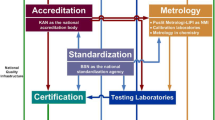Abstract
Nanotechnology is a global phenomenon already impacting, in some way, the scientific, technological, economic and social development, and the culture, of emerging economies, like Mexico’s. As any new technology, on one hand it has the potential to be one of the main sources of productivity growth for these economies, but on the other it can also be the origin of drawbacks if no appropriate actions are taken about. The effects of such impact depend on how the country prepares itself concerning the aforementioned aspects of development. Metrology constitutes a discipline which is transversal to all of these aspects. It has to move forward in order to face the challenges derived from nanotechnology, in proportion to the particular status of the country. Metrology has to be seen as an essential part of nanotechnologies. Any activity within science and technology must be accompanied by reliable measurements. The current paper describes issues and challenges in metrology to be faced in Mexico concerning this technology.




Similar content being viewed by others
References
M.L. Schattenburg and H.I. Smith, The critical role of metrology in nanotechnology, Proc. SPIE, Vol. 4608, (2001).
ISO/TS 27687 Nanotechnologies—Terminology and definitions for nano-objects—Nanoparticle, nanofibre and nanoplate, (2008).
Bureau International des Poids et Mesures. The International System of Units SI. 8a. Ed. (2008).
ISO TS 80004-1 Nanotechnologies—Vocabulary—Part 1: Core terms, (2010).
K. Schwab, ed., The Global Competitiveness Report 2012–2013, World Economic Forum, (2012).
Human Development Reports. Consulted at http://hdr.undp.org/en/statistics/, (August 2013).
Diagnóstico y Prospectiva de la Nanotecnología en México, Centro de Investigación en Materiales Avanzados, S. C., México, (2008).
J. González-Hernández, Actividades Estratégicas de la Red Temática de Nanociencia y Nanotecnología, Reunión de Seguimiento y Preparación de Actividades sobre Nanotecnología en México. Querétaro, México, (July 2013).
Nano Statistics. Consulted at www.statnano.com, (July 2013).
G. Foladori, N. Invernizzi, E. Záyago, Coordinators, Perspectivas sobre el Desarrollo de las Nanotecnologías en América Latina, Universidad Autónoma de Zacatecas, Red Latinoamericana de Nanotecnología y Sociedad, México, (2012).
E. Robles-Belmont, in Perspectivas sobre el Desarrollo de las Nanotecnologías en América Latina, G. Foladori, N. Invernizzi and E Záyago Coordinators. Universidad Autónoma de Zacatecas, Red Latinoamericana de Nanotecnología y Sociedad. México, (2012).
Programas de estudio. Red de Nanociencias y Nanotecnología. Consulted at www.nanored.org.mx, July (2013).
G. Delgado-Ramos, Guerra por lo Invisible: Negocio, Implicaciones y Riesgos de la Nanotecnología. UNAM, Mexico (2008). p. 33.
Roco M., Nanotechnology Development from Fundamental Discovery to Socio-economic Projects 2000-2020. Georgia Tech, 2012. Available at http://www.me.gatech.edu/files/nsf_onr_2012/plenary/Plenary%20Roco.pdf.
Memorandum for the Heads of Executive Departments and Agencies. Available at http://www.whitehouse.gov/sites/default/files/omb/inforeg/for-agencies/nanotechnology-regulation-and-oversight-principles.pdf.
Lineamientos para Regulaciones sobre Nanotecnologías para Impulsar la Competitividad y Proteger el Medio Ambiente, la Salud y la Seguridad de los Consumidores. Available at http://www.economia.gob.mx/files/comunidad_negocios/competitividad/lineamientos_regulaciones_nanotecnologias_261112.pdf .
T. Linsinger, G. Roebben, D. Gilliland, L. Calzolai, F. Rossi, N. Gibson, C. Klein, Requirements on measurements for the implementation of the European Commission definition of the term “nanomaterial”. JRC Reference Report, (2012).
Occupational Exposure to Titanium Dioxide, NIOSH Current Intelligence Bulletin 63, (April 2011).
Patrones nacionales. Consulted at http://www.cenam.mx/publicaciones/descargas/PDFFiles/cnm-pnm-2_2.PDF.
Gonzalez-Rojano et al., Nanometrología. In Nanociencia y nanotecnología. Panorama actual en México, Ed. N. Takeuchi, UNAM, Mexico, (2011).
The Key Comparison Data Base of the BIPM. Consulted at http://kcdb.bipm.org/AppendixC/default.asp.
G. Roebben, K. Rasmussen, V. Kestens, T.P.J. Linsinger, H. Rauscher, H. Emons, H. Stamm, Reference materials and representative test materials: the nanotechnology case. J. Nanopart. Res., 15 (2013) 1455.
Acknowledgments
The authors are indebted to Adi E. Lazos-Ruiz for her valuable review of the text.
Author information
Authors and Affiliations
Corresponding author
Rights and permissions
About this article
Cite this article
Lazos-Martínez, R.J., González-Rojano, N. Nanometrology in Emerging Economies: The Case of Mexico. MAPAN 28, 299–309 (2013). https://doi.org/10.1007/s12647-013-0083-8
Received:
Accepted:
Published:
Issue Date:
DOI: https://doi.org/10.1007/s12647-013-0083-8




